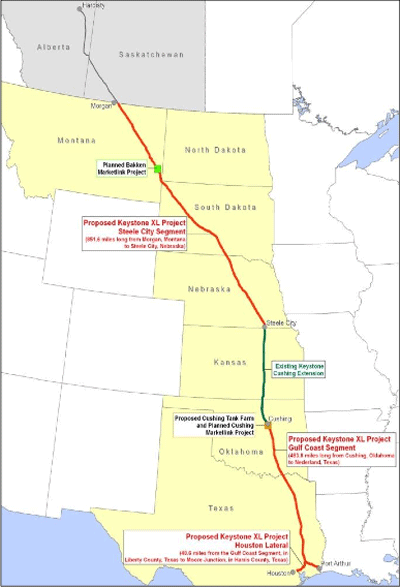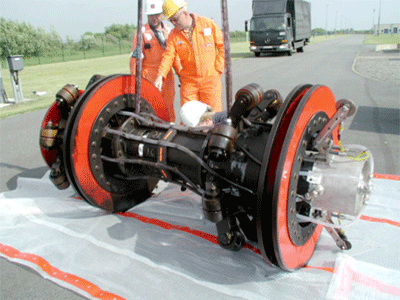|
Overriding concerns from Congress, other federal agencies and the public, the U.S. State Department has determined that the proposed Keystone XL Pipeline would have “no significant” environmental impact along its 1,700-mile route.
The State Department released the finding Friday (Aug. 26) in a nine-volume, 1,000-page Final Environmental Impact Statement (FEIS) on the project.
 |
|
Images: US Department of State |
| Native grasslands crossed by the pipeline in the Sand Hills region in Nebraska “would be challenging to reclaim,” the State Department assessment said. |
Although the FEIS does not constitute approval of the TransCanada Keystone Pipeline LP’s controversial project (“this is not a decision document,” Assistant Secretary of State Kerri-Ann Jones said), it removes a major hurdle and further inflamed tensions over the project.
$7 Billion Project
The State Department is charged with reviewing the $7 billion project because it crosses an international border. The FEIS is the State Department’s third, and final, review since TransCanada proposed the pipeline in 2008.
The pipeline would carry up to 830,000 barrels of crude oil per day and is expected to begin operation in 2013, if construction begins in 2012, the company says. The crude would be extracted from the oil sands areas in Alberta, Canada. Oil sands (also known as tar sands) are a combination of clay, sand, water, and bitumen.
 |
| The 1,700-mile pipeline would run from Alberta, Canada, to the Gulf of Mexico. |
Critics say tar sands oil is more corrosive to pipelines than regular crude and produces far more greenhouse gas emissions; backers say neither has been proved.
Oversight Criticized
The State Department has been widely accused of lax oversight on the project. In June, 34 members of Congress wrote to Secretary of State Hillary Clinton and Environmental Protection Agency Administrator Lisa Jackson, contending that the project itself was unnecessary and, in any case, had not been given sufficient review.
“We are concerned that, once again, the Department of State has failed to appropriately address issues that were ignored or inadequately analyzed in the first environmental review,” the group wrote, echoing similar letters of concern written by dozens of members of Congress in June 2010 and December 2010.
EPA has also called the State Department’s reviews of the project inadequate. Other federal agencies, including the Department of Homeland Security and the Department of Transportation, must still review the project.
1 Year, 14 Spills
Critics note that TransCanada’s current 1,300-mile Keystone system has experienced 14 spills since it began operation in June 2010, sparking intense debate over whether the company could safely operate the so-called Keystone XL project, which would nearly double the system’s capacity.
The XL project—officially, the Keystone Gulf Coast Expansion Project—would be the third phase of the $13 billion Keystone pipeline network.
A jubilant TransCanada president and CEO Russ Girling said the State Department's final assessment “continues to demonstrate the focus on safety and the environment that has gone into the development of this critical North American pipeline.”
Girling called the review process “the most exhaustive and detailed review for a cross-border pipeline that has ever been undertaken by of the Department of State.”
57 Special Conditions
The State Department FEIS notes that the agency has worked with the Pipeline and Hazardous Materials Safety Administration to develop 57 “Special Conditions” for the Keystone XL project. Those were developed in response to a 2009 application by TransCanada to operate the pipeline at a higher pressure than allowed. The company later withdrew the application, but the conditions remain in place.
 |
| TransCanada has agreed to use “smart pig” technology for pipeline monitoring. |
The State Department says that “incorporation of the Special Conditions would result in a Project that would have a degree of safety greater than any typically constructed domestic oil pipeline system under current regulations and a degree of safety along the entire length of the pipeline system that would be similar to that required in high-consequence areas as defined in the regulations.”
The conditions include:
• Special design standards to be used in manufacturing the pipe and requirements for pipe materials, pipe inspections at the mill and in the field, performance tests, and quality control procedures;
• System design, construction and testing requirements, including testing of project components;
• Requirements for the Supervisory Control and Data Acquisition (SCADA) system that would be used to remotely monitor and control the pipeline, as well as requirements for internal corrosion inspection, cathodic protection, identification of the location of the pipeline with aboveground markers, internal pipeline inspections using electronic sensing devices known as “smart pigs,” visual monitoring of the pipeline corridor, and repair procedures. The system would include automatic features that would ensure operation within prescribed pressure limits. There would also be a complete backup system.
• Requirements for maintaining detailed records, developing a right-of-way management plan, reporting to PHMSA, and providing PHMSA with certification from a senior officer of Keystone that it it has complied with the Special Conditions.
‘Limited’ Spill Potential
Despite TransCanada’s spill record, the State Department said the potential for spills “would likely be limited.”
It also noted that most of the land affected by the project is privately owned (21,333 acres), with nearly equal amounts of state (582 acres) and federal (579 acres) lands.
Jones, of the State Department, emphasized that no final decisions on the project had been made. The department will open a public comment period on the proposal this fall, with public meetings along the proposed route and in Washington, DC.
“This is not the rubber stamp for this project,” Jones told reporters. “The permit for this project has not been approved or rejected at all ... we will continue to have more discussion.”
Clinton’s final decision on the project is expected by the end of the year.
|

 Follow us on Twitter
Follow us on Twitter
 Join us on Facebook
Join us on Facebook









